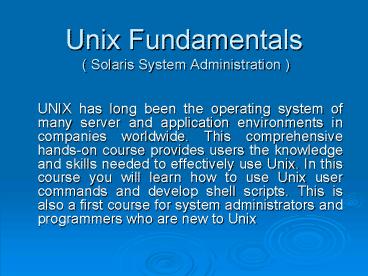Unix Fundamentals Solaris System Administration - PowerPoint PPT Presentation
1 / 10
Title:
Unix Fundamentals Solaris System Administration
Description:
In this course you will learn how to use Unix user commands and ... Housewife, Students who are learning computers. Prerequisites : None - Computer awareness ... – PowerPoint PPT presentation
Number of Views:662
Avg rating:3.0/5.0
Title: Unix Fundamentals Solaris System Administration
1
Unix Fundamentals ( Solaris System
Administration )
- UNIX has long been the operating system of many
server and application environments in companies
worldwide. This comprehensive hands-on course
provides users the knowledge and skills needed to
effectively use Unix. In this course you will
learn how to use Unix user commands and develop
shell scripts. This is also a first course for
system administrators and programmers who are new
to Unix
2
Course Objectives
- Manage files and directories create, copy,
rename, remove, edit, and perform other
operations. - Create and modify files using the vi editor.
- Use many UNIX utilities for text file
manipulation, personal workspace management, file
system management, and communication with other
users. - Take advantage of UNIX security mechanisms to
protect files and programs from unauthorized
access and to configure shared access among work
groups. - Use the UNIX shell (command interpreter) to
control the flow and processing of data through
pipelines. - Increase your productivity by generating file
names using "wild card" pattern matching. - Look up commands and other information in the
on-line UNIX reference manuals. - Explain the purpose of shell programs.
- Recognize applications for shell programs.
- Design and write shell programs of moderate
complexity. - Manage multiple concurrent processes to achieve
higher utilization of UNIX.
3
(No Transcript)
4
Audience
- This course would be useful for any common
Non-UNIX person. - This will build the solid base foundation.
- It will be useful throughout the career.
- Housewife, Students who are learning computers
- Prerequisites None - Computer awareness
5
(No Transcript)
6
Course Curriculum
- Course Length 20 hours session
- Student Material
- Quick reference card
- Student workbook and textbook
- Enough course material will be provided with
respect to notes and selected manuals. - CBT Material will be Included
7
Course Contents
- 1. Course Introduction
- Course Overview
- Course Objectives
- Suggested References
- 2. Getting Started
- What is UNIX?
- A Brief History of UNIX
- Logging In
- Logging Out
- Try a Few More Commands
- Changing Your Password
- Using On-line Manuals
- 3. The File System - Files
- What is a File?
- The ls Command
- The cat Command
- The more and pg Commands
8
- 6. More Editing With vi
- Scrolling the Buffer
- Cursor Motion Commands - w, W, b, B, e, E
- Cursor Motion Commands - , , 0, G
- Cursor Motion Commands - f, t, F, T
- Delete Operator - d
- Change Operator - c
- Yank Operator - y
- Put Commands - p, P
- Searching For a Pattern - /, n, N, ?
- The join Command
- The file Command - f
- Edit file Command - e
- Cut and Paste Between Files
- Read file Command - r
- Set options Command
- Set options Command - .exrc file
- 7. Personal Utilities
9
- 11. Communication Utilities
- The write and talk Utilities
- The mesg Utility
- Mail Overview
- The mail Utility
- The mailx Utility
- 12. Using the Shell
- What is a Shell?
- Which Shell?
- The Command Line
- Standard Input, Standard Output and Standard
Error - Using Default Standard In and Standard Output
- I/O Redirection
- Appending Output of a File
- Pipes
- The tee Utility
- 13. Filename Generation
10
- 17. Variables
- User Created Variables
- The read Command
- The Shell Environment
- The export Command
- Sub-shells
- Command Substitution
- Quoting Mechanisms
- Assigning Variables - Summary
- 18. Special Variables
- Command Line Arguments
- - Number of Arguments
- The shift Command
- - All Arguments
- - PID of Shell
- 19. More Flow Control
- The for Loop
11
Summary
- This course will give you good knowledge on basic
UNIX. - You can start as Junior UNIX Admin job
- Also if you go next level with advance admin you
can earn high dollars. - This area is usually stable and long term career
opportunity in this field. - My goal is to train you and place you.































